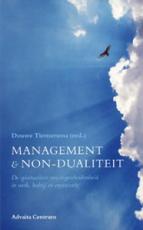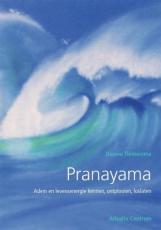Advaita Post, Volume 13 No 11 - How far...
May 31, 2012
--- How far does your realization go? How concrete is your realization? ---
Trying to hold back the infinite sea just doesn't work.
*****
Prior to everything
Transcending everything
I am everything
*****
Nisargadatta's teaching
In: InZicht Magazine Volume 14, No. 2 (May 2012)
Many are familiar with the teaching of Nisargadatta Maharaj. Yet it seems a good idea to review its key elements. By doing so a sharper insight can arise into the essence of advaita and so too your own situation.
A first point is the distinction of the levels of realization that are frequently steps on the path towards the realization of the highest non-duality. Knowledge of this geography is necessary for becoming aware of where you currently are and also brings the possibility of recognizing further steps.
The witness
The first step is turning within to the position of the observer from which you keep looking out towards everything that shows itself. This turning within means a withdrawal and so too, a distance taking. Through this, a larger viewing area arises in which more of yourself becomes visible. All kinds of impressions, feelings and images of your own body are now visible as phenomena in the field before you. Initially you saw the world from the standpoint of your body with your eyes. You were your eyes! They belonged to yourself as a the subject of perception. Now after withdrawing, you experience your eyes as a phenomenal object, there, in a particular place. Then it's clear that you don't fully coincide with those eyes, that you are not those eyes. So too, it's also clear that you don't fully coincide with the body that you have previously simply been, that you don't coincide with your mental activity and your self-image, which you used to consider to be identical with yourself. What are you then? The observer who effortlessly watches everything, the witness who sees everything without entanglement with the observed, an awareness which registers everything.
I-am
Then what about non-duality? The observer is clearly separated from that which can be observed. Initially that is important in order to break through the identification with the observed. That identification leads to a worldly duality: "I am this body and not that", "I am this person and that is someone else". On the level of the detached observer there is, so to speak, a cosmic duality of observer and world. For a universal non-duality to arise the distance observer-observed will need to disappear in a universal way.
Through this shift it's evident that you as observer still have a certain kind of body. Even though much of the body has already disappeared, there's still the condition of a particular place with a particular perspective and an energetic concentration. This concentration of yourself as being-awareness can disappear. Take a look at the space all around you, turn yourself around and relax. Then an infinite expansion of your being-awareness arises whereby everything becomes absorbed in a universal non-duality without a center. This self sphere has not only the qualities of being and consciousness, but also of love. The universal expansion can only take place in love, because it means that emotionally you accept everything and everyone as yourself. So that infinite sphere of being-consciousness is also bliss, heavenly ananda. It is the sphere of universal self-being where this being-there needs no further predication, a cosmically present being without forms. There is the affirmation that 'I am here' as universal being-awareness. Within it there is no 'I'-center, not a single structure. When any phenomena arise through a process of differentiation, you remain yourself in a universally aware manner and remain everything, including this universality. Therefore there is a non-duality of yourself with everything and everyone.
The absolute
Awareness of the qualities of the universal being-self-being can increase. Apparently, as being-awareness, you don't fully merge therein. When that increase in awareness occurs and continues, the last qualities dissolve, including the 'I-am'. Then there is the final and complete surrender. That, within which everything dissolves, and to which you finally surrender, is something about which nothing can be said because It has no properties. It is the absolute, a groundless openness in which the limitations of self-being disappear. That is the ultimate liberation (moksha) from the conditions in which the self was entangled. This liberation is a clear being-experience without an "I experience", even though there is the confirmation that the truth of the ultimate openness has always already existed. Then also there's the knowledge of the beginning of creation. The groundless openness is the foundation for the origin of the being-awareness, the 'I am' in a universal sense, from which the limited forms of self-being and the countless forms of the world appear. When you consciously remain on the edge of the absolute, without shooting into the quality 'I-am' and into a particular form, there is a non-duality of the absolute and the relative, the world. When there is no duality there is no conflict and no suffering.
How concrete is your realization?
The above description may become mentally quite clear at a given point. Then it's information which can be reproduced. It can even be replicated in the form of a diagram. That is important in a particular phase. In the tradition of Advaita Vedanta, three stages of Jnana Yoga are described. The first phase is hearing the instruction from a teacher (shravana). It's about becoming acquainted with the important points of the advaita vision, including "you are That." The student meditates on that material in the second phase (manana) and strives to put everything in order mentally, so that he or she can see the logic in the instruction. Then the philosophy can be reproduced and debated.
This is done quite frequently in advaita circles. But to what extent is there is an actual realization of the non-duality to which it all refers? That's especially what it was about in the talks with Nisargadatta. He immediately poked through the mental shell and showed how futile it is. The word realization means that you realize the truth, that you are aware of the truth of the teachings. But it also means that the truth is a reality for you, that it is your own reality. This means that you release your limited identity and its corresponding world, and you are aware of your new reality. It already begins with the first step, the transition toward the position and the world of the observer. To what extent have you truly made that step? To what extent has there been a shift away from your daily functioning self to the witness? To what extent has the witness-situation stabilized? You can certainly talk about yourself as the effortless observer of all, as the witness who is not involved in events. But is that a concrete realization? This means that you're actually present on that level, in the insight body which corresponds to it. Reality only arises through that body. Here too, only when this occurs very concretely is there a realization. This shifting of your own identity and reality can take place quite quickly and spontaneously, but usually there is a development, a third stage on the path of liberation after hearing and contemplating: that of constant meditation (nididhyâsana), where the truth that the student has heard and thought about becomes their own. For this there is an unremitting and complete dedication, a continual sharpening of the focus, a release of old feelings, images and concepts and an acceptance of the new situation.
The same applies to the realization of the universal 'I-am'. Visitors who didn't have this realization, urged Nisargadatta to devote himself entirely to the universal being-consciousness. To the limited human being this appears as the divine reality and can only be realized as your own through devotional dedication and surrender. Nisargadatta would say: "Dedicate yourself completely to the 'I-am' as your supreme god". Which means that you commit yourself completely, without distraction. Otherwise, nothing happens. Here too, the full realization will need to be complete, so that all aspects of yourself enter into it. You will have to recognize the characteristics of your situation very concretely. Many elements of the daily 'I-person' have already dissolved therein, but on this level of 'I-am' there is still a substance with qualities that have to do with the physical existence. The cosmic realm of 'I-am' is physical. Physically you are the cosmos: the causal or bliss-body. Can you very realistically experience the cosmos as your body without a single structure? A mental knowing and a psychological recognition is not enough. Only when the 'I'-center and the entire dualistic reality has very concretely dissolved in the actual experience is it clear that there is a realization of the infinite, divine, 'I am'. To what extent is this the case? To what extent is the realization of your cosmic identity stable? To what extent can life continue without returning to a particular form of life? Only through the complete realization of the stable 'I-am' can the still higher realization of the source of 'I-am', the absolute, arise. Nisargadatta said: "... becoming stabilized in the awareness 'I Am' is all that is important. Later on, you will also transcend that 'I Amness'. "
How far does your realization go?
Realization can take place on different levels. In his last years Nisargadatta Maharaj spoke almost exclusively about the universal self-being and its merging in the absolute. He drove his visitors towards it. He had no time to explain all the preceding phases. The shift of the everyday standpoint towards that of the witness is a first step. But however important it is to observe the worldly and mental events in a free manner, it's still a first phase. The realization will need to go further, first to the level of the universal 'I-am', then to the edge of the absolute.
Why did Nisargadatta send away so many people who came to him? It wasn't only because he no longer had no time to explain everything from the beginning. It was also because he saw how stuck many visitors were in their own personal experiences, feelings and ideas. That was precisely the case with the high-spiritual seekers, the yoga teachers, the people touring the sacred places and teachers in India, those who had studied a great deal about Indian philosophy and culture, students from other teachers. What do you do with people who are stuck in their ideas, feelings and spiritual experiences, in their enjoyment of the flow of life, in the distraction of their spiritual attention? Many of them quickly left the cramped attic by themselves where they just saw a toothless old man. Others were sent away. Some didn't want to leave and found Nisargadatta hard because their own world had been attacked. An 'I'-person also can't accept being cut off. And that was precisely what it was about. The ultimate reality can only be realized through your own involvement in letting go of certain forms and qualities, however spiritual, in your own 'I-center', by releasing the quality 'I-am'.
When much is released, a feeling of space arises and creates a sense of joy and happiness. Life flows in a spontaneous and creative way. There is enthusiasm, because this is something big. The sphere of life, of being-there, becomes infinitely large as the 'I-center' truly disappears. Then it is difficult, but even more important, to see how much this self-being is stuck in conditions. Nisargadatta Maharaj showed that this 'I-am' is a condition that is entirely dependent on the material food body. When this falls apart, nothing of the greatest spiritual being remains. To clarify his point Nisargadatta referred to the incense stick since the fire and the fragrance as essence depend upon the material surrounding that stick. When the combustible material is gone, everything is gone. He flicked his cigarette lighter on and then closed it. So too, there is life, even in a higher essence, then it stops. Only the jnani, the knower, knows himself as independent, free from the food body and from the mental life that is a condition of that body.
The realization begins in the situation in which you currently find yourself, wherever and whatever. You must accept this situation, because apparently it is your manner of being. The realization can continue therein. It can continue radically. It will need to continue radically, because otherwise you will keep digging in a sphere that isn't free and contains suffering. That radicality goes beyond the witness, also in its awareness, and beyond the sphere of the free life, of sat-chit-ananda, of the 'I-am' without a center. True realization is of That which is beyond all conditions, but which can be referred to as the Inexpressible, the groundless openness, the origin prior to life, time and space.
That the truth was independent of conditions was clear in the slums of Khetwadi Lane. There, the sound of the deafening traffic, the dirt and stench didn't matter, nor did the frail, dying body of Nisargadatta Maharaj. There was, for the few who were there for it, only the light of the truth that swept away every condition. In that light there was an infinite gratitude and a further radiation of that light.
*****
Er is geen tweeheid
als je ontspannen bent
in zelf-bewustzijn
is dat duidelijk.
Boeken
Douwe schreef en redigeerde gedurende zijn leven boeken. Via onze uitgeverij zijn deze nog verkrijgbaar.



